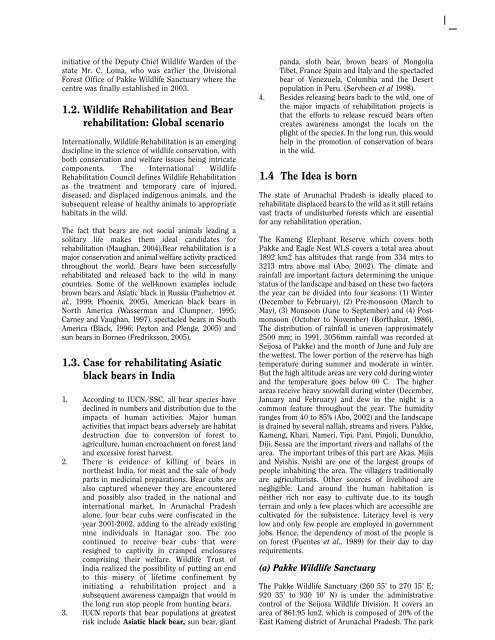Walking The Bears.pdf
Walking The Bears.pdf
Walking The Bears.pdf
- TAGS
- walking
- www.ifaw.org
Create successful ePaper yourself
Turn your PDF publications into a flip-book with our unique Google optimized e-Paper software.
initiative of the Deputy Chief Wildlife Warden of the<br />
state Mr. C. Loma, who was earlier the Divisional<br />
Forest Office of Pakke Wildlife Sanctuary where the<br />
centre was finally established in 2003.<br />
1.2. Wildlife Rehabilitation and Bear<br />
rehabilitation: Global scenario<br />
Internationally,WildlifeRehabilitationisanemerging<br />
discipline in the science of wildlife conservation, with<br />
both conservation and welfare issues being intricate<br />
components. <strong>The</strong> International Wildlife<br />
Rehabilitation Council defines Wildlife Rehabilitation<br />
as the treatment and temporary care of injured,<br />
diseased, and displaced indigenous animals, and the<br />
subsequent release of healthy animals to appropriate<br />
habitats in the wild.<br />
<strong>The</strong> fact that bears are not social animals leading a<br />
solitary life makes them ideal candidates for<br />
rehabilitation (Maughan, 2004).Bear rehabilitation is a<br />
majorconservationandanimalwelfareactivitypracticed<br />
throughout the world. <strong>Bears</strong> have been successfully<br />
rehabilitated and released back to the wild in many<br />
countries. Some of the well-known examples include<br />
brown bears and Asiatic black in Russia (Pazhetnov et.<br />
al., 1999; Phoenix, 2005), American black bears in<br />
North America (Wasserman and Clumpner, 1995;<br />
Carney and Vaughan, 1997), spectacled bears in South<br />
America (Black, 1996; Peyton and Plenge, 2005) and<br />
sun bears in Borneo (Fredriksson, 2005).<br />
1.3. Case for rehabilitating Asiatic<br />
black bears in India<br />
1. According to IUCN/SSC, all bear species have<br />
declined in numbers and distribution due to the<br />
impacts of human activities. Major human<br />
activities that impactbears adversely are habitat<br />
destruction due to conversion of forest to<br />
agriculture,humanencroachmentonforestland<br />
and excessive forest harvest.<br />
2. <strong>The</strong>re is evidence of killing of bears in<br />
northeast India, for meat and the sale of body<br />
parts in medicinal preparations. Bear cubs are<br />
also captured whenever they are encountered<br />
and possibly also traded in the national and<br />
international market. In Arunachal Pradesh<br />
alone, four bear cubs were confiscated in the<br />
year 2001-2002, adding to the already existing<br />
nine individuals in Itanagar zoo. <strong>The</strong> zoo<br />
continued to receive bear cubs that were<br />
resigned to captivity in cramped enclosures<br />
comprising their welfare. Wildlife Trust of<br />
India realized the possibility of putting an end<br />
to this misery of lifetime confinement by<br />
initiating a rehabilitation project and a<br />
subsequent awareness campaign that would in<br />
the long run stop people from hunting bears.<br />
3. IUCN reports that bear populations at greatest<br />
risk include Asiatic black bear, sun bear, giant<br />
panda, sloth bear, brown bears of Mongolia<br />
Tibet,FranceSpainandItalyandthespectacled<br />
bear of Venezuela, Columbia and the Desert<br />
population in Peru. (Servheen et al 1998).<br />
4. Besides releasing bears back to the wild, one of<br />
the major impacts of rehabilitation projects is<br />
that the efforts to release rescued bears often<br />
creates awareness amongst the locals on the<br />
plightofthespecies.Inthelongrun,thiswould<br />
help in the promotion of conservation of bears<br />
in the wild.<br />
1.4 <strong>The</strong> Idea is born<br />
<strong>The</strong> state of Arunachal Pradesh is ideally placed to<br />
rehabilitatedisplacedbearstothewildasitstillretains<br />
vast tracts of undisturbed forests which are essential<br />
for any rehabilitation operation.<br />
<strong>The</strong> Kameng Elephant Reserve which covers both<br />
Pakke and Eagle Nest WLS covers a total area about<br />
1892 km2 has altitudes that range from 334 mtrs to<br />
3213 mtrs above msl (Abo, 2002). <strong>The</strong> climate and<br />
rainfall are important factors determining the unique<br />
statusofthelandscapeandbasedonthesetwofactors<br />
the year can be divided into four seasons: (1) Winter<br />
(December to February), (2) Pre-monsoon (March to<br />
May), (3) Monsoon (June to September) and (4) Postmonsoon<br />
(October to November) (Borthakur, 1986).<br />
<strong>The</strong> distribution of rainfall is uneven (approximately<br />
2500 mm; in 1991, 3056mm rainfall was recorded at<br />
Seijosa of Pakke) and the month of June and July are<br />
the wettest. <strong>The</strong> lower portion of the reserve has high<br />
temperature during summer and moderate in winter.<br />
Butthehighaltitudeareasareverycoldduringwinter<br />
and the temperature goes below 00 C. <strong>The</strong> higher<br />
areasreceiveheavysnowfallduringwinter(December,<br />
January and February) and dew in the night is a<br />
common feature throughout the year. <strong>The</strong> humidity<br />
ranges from 40 to 85% (Abo, 2002) and the landscape<br />
isdrainedbyseveralnallah,streamsandrivers.Pakke,<br />
Kameng, Khari, Nameri, Tipi, Pani, Pinjoli, Dunukho,<br />
Diji, Sessa are the important rivers and nallahs of the<br />
area. <strong>The</strong> important tribes of this part are Akas, Mijis<br />
and Nyishis. Nyishi are one of the largest groups of<br />
people inhabiting the area. <strong>The</strong> villagers traditionally<br />
are agriculturists. Other sources of livelihood are<br />
negligible. Land around the human habitation is<br />
neither rich nor easy to cultivate due to its tough<br />
terrain and only a few places which are accessible are<br />
cultivated for the subsistence. Literacy level is very<br />
low and only few people are employed in government<br />
jobs. Hence, the dependency of most of the people is<br />
on forest (Fuentes et al., 1989) for their day to day<br />
requirements.<br />
(a) Pakke Wildlife Sanctuary<br />
<strong>The</strong> Pakke Wildlife Sanctuary (260 55’ to 270 15’ E;<br />
920 35’ to 930 10’ N) is under the administrative<br />
control of the Seijosa Wildlife Division. It covers an<br />
area of 861.95 km2, which is composed of 20% of the<br />
East Kameng district of Arunachal Pradesh. <strong>The</strong> park

















